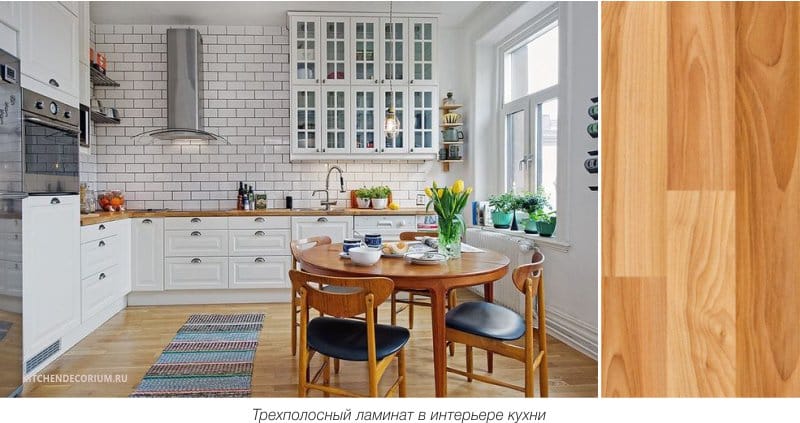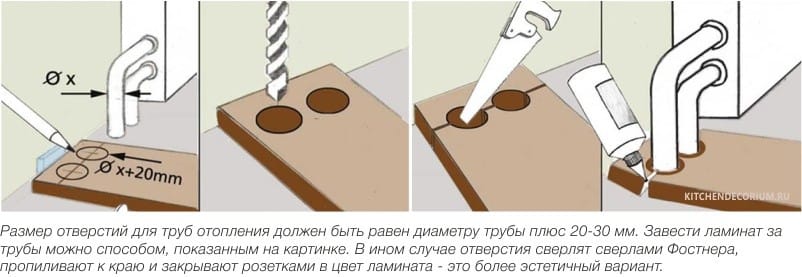Laminate flooring is often referred to as “laminated parquet” and an inexpensive alternative to parquet or solid wood. That is how he was conceived by manufacturers, and today he can reliably copy and tile. If you want to have the same floor throughout the apartment, then you most likely wondered whether it is possible to lay laminate flooring in the kitchen and how practical it will be. Be sure, modern laminate can not just copy ceramics and wood, but also adequately replace them in their performance characteristics. The main thing is to choose the right wear resistance class, type of coating, beautiful and non-marking design, and, of course, to put it in your own hands with high quality.
Laminate is a material consisting of medium density (HDF) fiberboard and paper impregnated with melamine resins, on which the drawing is applied.

Composition:
- The upper acrylic or melamine layer overlay (thickness overlay) not more than 1 mm thick, protects against wear.
- The decorative layer is several or one paper with a pattern impregnated with melamine resins.
- Damper - intermediate protective and decorative, sound-absorbing, increasing the impact strength of the layers. Most often made from impregnated kraft cardboard.
- The HDF plate is a basic wood-fiber layer 6-8 mm thick.
- Stabilizer - a layer of paper impregnated with paraffin or resin that protects against warping. Does not allow the hardboard to respond to changes in temperature and humidity.
Pros - Cons

The main advantage of the laminate - it is a good copy of expensive materials, not much inferior to them in durability and practicality, while cheaper.
Affordable price does not deprive the coating of functionality - high-quality laminate flooring can be laid in the kitchen, since the coating is easy to clean, does not lose color under ultraviolet rays, is not afraid of stains, bumps, cracks or scratches. Really high-quality material will be resistant to abrasion.
How is it better than other flooring - tiles, linoleum, self-leveling floor, parquet and solid wood?
- It is warmer than the tile and less noisy;
- Unlike parquet and solid wood boards, there are no traces of stiletto heels on the laminate;
- On the laminate does not remain dents from heavy kitchen furniture, which is typical of linoleum;
- It can be easily put with your own hands and without a partner - unlike a self-leveling floor, for example;
- Laminate flooring is practically the most affordable type of flooring.
Nevertheless, if in the bedroom and living room laminate can be called an ideal covering in all respects, then in the specific conditions of the kitchen it still has some drawbacks.

- Some types of laminate really cannot (or can, but with care) be placed in the kitchen, as they cannot withstand either increased humidity, or temperature fluctuations, or spilled coloring liquids like wine or beetroot, and can be deformed from falling heavy and sharp objects. How to choose a laminate for the kitchen will tell below;
- The disadvantages of the laminate can be attributed, and quite a sonorous sound, which forms a coating at the steps or falling objects. However, this drawback is more likely a consequence of incorrect installation than the problem of the material itself. The “defect” is eliminated with the help of a special sound-absorbing substrate;
- There is an opinion that the laminated coating is not environmentally friendly. But manufacturers with a well-deserved reputation in the market refute this misconception by conducting serious tests for the toxic safety of their products. Conducting such tests is confirmed by a hygienic certificate that accompanies each batch of material;
- Artificiality - no matter how authentically it imitated the original materials, it still remains a copy and, in one way or another, loses them in its aesthetic and operational qualities.
How to choose a coating by strength class

How to choose a laminate for the kitchen? First of all, you need to focus on the strength class.
This class is indicated by two numbers. Coatings of class 21, 22, 23 are intended for domestic use - in order of increasing resistance. According to this classification in the kitchen you can put laminate 23 class, it is inexpensive, but it will serve no more than 4 years, since it consists of only three layers.
In fact, household type laminate of class 21 and 22 is no longer for sale in stores. The reason is the lack of demand. In Russia, the most popular commercial type.
The material of commercial classes 31, 32, 33 is considered more durable. But the 31st class of wear resistance is more suitable for bedrooms and living rooms, and for the kitchen it is better to choose 32, 33, 34+ classes. This floor is able to serve in the kitchen for about 25 years.
Commercial coatings consist of five layers:
- Moisture resistant film at the base;
- High density wood board;
- Decorative layer of durable paper;
- Acrylic resin to protect the decor;
- Moisture resistant top film.
Moisture resistant or waterproof coating?

High-quality modern laminated panels are practically not afraid of water - as a protective layer, special water-repellent compositions based on wax are applied to them. However, the joints between the panels are treated by no means all manufacturers, and therefore these parts of the coating remain susceptible to moisture.
For the kitchen, you can choose:
- Moisture resistant coating - does not react to increased humidity in the room, but the base may be deformed if water gets into the joints. Able to withstand drops, splashes and even small pools, but the exposure time of the liquid should be no more than 20 minutes. In this case, sealing requires the sealing of joints.
- Waterproof laminate is more expensive, but can resist moisture for 6 hours. Here the joints are processed in the factory, so that additional measures for their protection is not required. The most reliable is a laminate with a plastic base, but it is also the most expensive.
Types of decor


Choosing laminate for the kitchen can be confused - there are a lot of options for the design, colors and textures: from copies of cork floor to imitation of snake skin. The most popular option is a “wooden” design for a massive board with a 1: 9 or 1: 6 format. High-quality laminate is so similar to parquet that it even has a fibrous texture on the surface.
In addition, manufacturers offer laminate with chamfers on its transverse and longitudinal sides, so that it is most similar to wooden parquet boards.


Also, before going to the store, keep in mind that the laminate can have one, two, three or many stripes in the plate. Think what you like more.





Color, texture, "wood" should be chosen based on personal preferences and focusing on the color of furniture and flooring in other rooms. In addition, if the interior of the kitchen is dominated by cold colors, then the laminate is better to choose with a cold subtone. In the photo below, the floor design in the “cold” interior of the kitchen was chosen on the basis of this rule.

And in the next photo there is a brown laminate in the interior of the kitchen with the prevailing warm colors in the furniture and decoration.

But this recommendation is, of course, not a dogma. Neutral wooden shades can harmoniously fit into the kitchen of any color and design.

Read more about the combination of colors in the kitchen interior. here.
Light and dark laminate - not the easiest to care options. On a dark surface, crumbs, dust, spots, light pet hair, etc. will be visible. On light coatings, all defects such as chips and swollen joints will be noticeable.
In terms of practicality, the best colors are gray and traditional brown.

The tile floor also has a similar “ceramic” texture with roughness and porosity, and a form with an aspect ratio of 1: 3 or 1: 4. But this option is not in great demand, since instead of “tile copy” it’s better to use real tile.
See also: How to join tile and laminate with or without a threshold - 5 solutions
Laminate laying rules
Coverage with modern castle system is easy to lay even for a beginner without any experience. To do this, you need to take into account just a few nuances. So, how to put a laminate with their own hands.
Concrete, wood or even tile can be used as the base for such a floor. It is important that the base is smooth, without cracks and with high-quality waterproofing. Clearances are allowed under the rule of no more than 2 mm / rm.
When buying a laminate, you need to purchase material with a 10% margin. Subsequently, it will help to easily perform local repairs.
Laminate can be mounted along or across the room, as well as diagonally. It is believed that the joints are practically not visible if you lay the floor in the direction of the sun's rays falling from the window.
Laminate installation technology is simple:
- The base is leveled. In the case of concrete surfaces - a new screed is poured.
- Mounted substrate, necessarily overlap over the entire surface of the floor.
- Flooring is conducted from the corner of the room.

- A compensating gap of about 8-10 mm (but not less) is allowed around the wall and around the pipes, allowing the material to "float". Subsequently, it is hidden plinth.

- The laminate is laid in a checkerboard pattern - so that the transverse joining seam is interrupted.
If the laminate still seems to you not strong enough for the working area, then you can put ceramic tilesas shown in the photo below.

How to properly put the laminate with their own hands, in great detail, clearly and professionally described in this video:
- Gender is relative: choose flooring for the kitchen
- Self-leveling kitchen floor
- Cork flooring - 99% ideal floor covering for the kitchen
- Floorboard in the kitchen - all the pros and cons
- Everything about linoleum for the kitchen - compare, choose and lay your own hands
- Porcelain tiles in the kitchen - 99% perfect floor



 (Rate the material! Already voted:22 average rating: 4,36 from 5)
(Rate the material! Already voted:22 average rating: 4,36 from 5)
Yes, now many people choose laminate for the kitchen, of course, with the advent of high-quality waterproof coating, the material has become more popular for use for the kitchen.
The tile is a thing of the past for the kitchen (especially since it can crack). Previously, the laminate for the kitchen was not desirable due to the lack of protection against water, but now there are enough protective varnishes that protect the laminate and prevent it from swelling.
Is it difficult to wash off such laminate from grease or old stains? And is it possible to use detergents and cleaners
Not harder than any surface) Detergent specialized means - the sea.
Strange why there is not a single mention of a special sealant for the seams? In the kitchen, in any case, water will be spilled, and hot, and the sealant will insure against these incidents)))
we just marked the need for sealing the seams))
Hmm ... The article told me that any laminate will not go to the kitchen, it was very interesting to read. I think to make a bed in the kitchen that would be cozy and beautiful ...
We also have laminate flooring in the kitchen. There are no problems with moisture protection, although laminate is not a luxury. But with shock resistance. A lid from the frying pan was dropped a couple of times and chips were left on the surface ((Therefore, when choosing a laminate for the kitchen, you need to pay attention to its impact resistance.
It is best to buy a moisture-resistant laminate in the kitchen because otherwise it will have to be changed quickly, because anything happens in the kitchen and water is shed too often.
Tell me, if you decide to divide the kitchen into two zones, the cooking zone, where the floor is covered with tiles, and the eating area, where there will be a laminate. Question: how to choose a tile-laminate color, what should be a combination of colors in order to visually separate these zones.